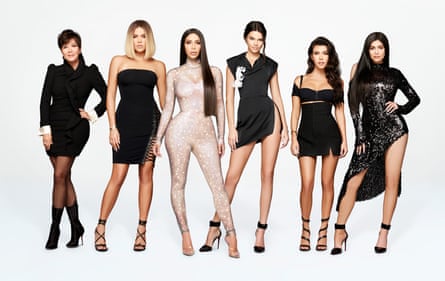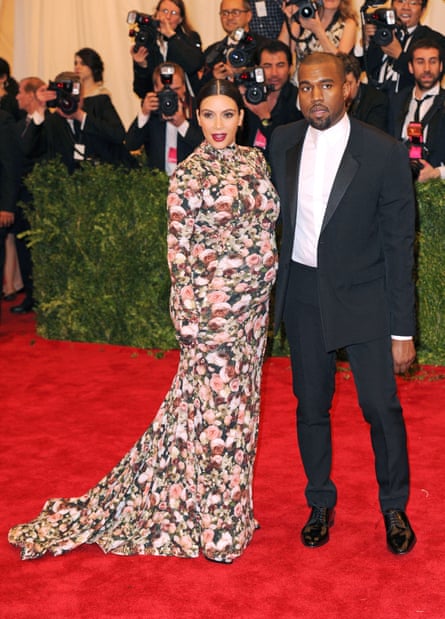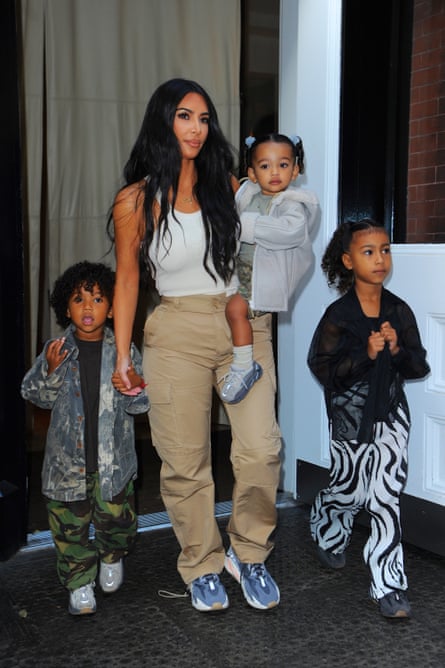In the early hours of 3 October 2016, shortly before her 36th birthday, Kim Kardashian West found herself with a gun to her head, tied up in a rented apartment in Paris, begging for her life.
Over the previous few days, Kardashian West had posted 15 images on Instagram documenting her trip to Paris fashion week, including a selfie showing off a $4m diamond ring on her finger. The thieves took off with more than $9m worth of her jewellery.
By this point in her career, Kardashian West was one of the most famous women in the world. The socialite daughter of OJ Simpson’s lawyer Robert Kardashian, former assistant to Paris Hilton and reality TV star had amassed more than 85 million followers on Instagram, documenting every part of her life, family, fertility journey and marriage. Other celebrities might double down on security following a near-death experience, Kardashian West reacted by temporarily leaving Instagram. After she returned, she refrained from posting images in real time. Instead, she said, she would “video something and then post like 30 minutes later”.
The same day Kardashian West was robbed, the pseudonymous novelist Elena Ferrante was allegedly “doxxed” – unmasked – by an Italian journalist. Immediately, parallels were drawn between the reality TV star and the reclusive writer: here were two women, with polar opposite approaches to their privacy, both targeted for not disclosing the correct amount. Doubts over the veracity of the robbery were raised. Maybe the Instagram celebrity with the curated existence hadn’t really been robbed at all and it was all a stunt for yet more publicity – or if she had, perhaps that was the price you paid for violating your privacy for the benefit of a multimillion-dollar business.

Kardashian West – mother of four, breaker of the internet – turns 40 this week, and is marking the move into middle age by launching a shapewear line in the UK, appearing on the cover of Grazia magazine alongside an interview about said shapewear, donating $1m to the Armenian relief fund and becoming Martha Stewart for the pandemic generation with a soon-to-be launched interiors line, KKW Home (towels, shower curtains, sponges). Naturally, all of this news was diffused through her social media accounts. She now has 190 million Instagram followers, just shy of the population of Nigeria, a total that makes Donald Trump’s 87 million Twitter followers pale in comparison.
There are few people who define the times in which we live quite like Kardashian West. In the age of platform capitalism, where every person on social media is a product, she is queen. In the post-truth world, where our lives are curated not lived and nothing can be trusted, she manages to be ubiquitous yet strangely unreal; her mundanely familiar existence – parenting, bickering, wearing clothes – just happens to be performed to a global public.
You might ask why she is so famous – but perhaps the more interesting question is how. How can an American woman market her body and lifestyle so skilfully she becomes a global celebrity? How can someone who merely posts images of themselves become one of the most divisive figures in modern times? Much of her undulating value (this month, Forbes put her worth at about $750m) has come from being hated, or envied, or both. Questions surrounding her bottom (she x-rayed her rear on TV to prove it was real), her bone structure (fillers and Botox, but no surgery, she says) and authenticity (see above) have plagued her career. But for Kardashian West, criticism and publicity are probably just one and the same thing.

Such is her enormous power that when establishment intellectuals want to make a knowing point about vulgar popular culture, the name they reach for is hers. I recently asked a prominent magazine editor why Kardashian West’s fame has lasted this long. “There are moments when I think that Kim Kardashian must be the Andy Warhol of our times. A master of publicity,” they replied. “But then I think better of it.” It is what Renaissance scholar Stephen Greenblatt calls “self-fashioning”, the presentation of what and who you are, not as something fixed and private, but as something you yourself created, almost for survival.
It was in 2010, just three years into Keeping Up With The Kardashians, the reality TV programme about her family, that Kardashian West decided: “I’ll do anything …” – by which she meant put her name and face to anything. “Cupcakes, milkshakes …” she said. From then on, dubious weight-loss products were shilled, and many perfumes followed, and all the while Keeping Up With the Kardashians continued to expand, expelling new arms of a Kardashian empire that would include fashion, prepaid credit cards (the Kardashian Kard), skin care, eyelashes, apps, emojis and underwear. All this while Kim and her family bedded into the turgid soil of a world fighting its losing battle with reality TV stars, with the Apprentice frontman Trump – a sometime ally of her soon-to-be husband Kanye West – the most stark example.
Just as people searching online for pictures of Jennifer Lopez in a green Versace dress in 2000 was the catalyst for the creation of Google Images, so Kardashian West can lay claim to the “modern selfie”. Her brand of pouting face, corseted waist and extraordinary bottom is so pervasive that she is often cited as the reason for the rise of Botox, fillers and bum-lift surgery. Although the Kardashian West aesthetic would come to define the platform, she was actually late to join Instagram. But her first post, taken on her Blackberry in 2012 – hair scraped back in signature eye-lift style, contoured so as to completely rebuild the architecture of her face – showed a woman not simply in control of her own image, but of the possibilities that the internet had created, and its magical, mythmaking ability.

That year, 2012, was also when she got together with Kanye West. It was charming. They were friends. If it seemed like a joke (naming their daughter North West didn’t help), it swiftly pivoted to something more awe-inspiring – the beginnings of a power couple who would, by the summer of 2020, facilitate each other’s ascent into superstardom. In 2014, the couple appeared on the cover of Vogue. The shot drew swathes of criticism, mainly from the fashion industry, questioning Kardashian West’s fashion credentials. Vogue’s editor, Anna Wintour, was defiant, however. In her editor’s letter, she wrote: “Part of the pleasure of editing Vogue … is being able to feature those who define the culture at any given moment.”
They continued to define culture. By late 2014, Kim and Kanye were married, and Kardashian West’s style had morphed from “barely there” to something subtler. West, it transpired, had become pivotal in what she wore. “My husband has voiced that sometimes too sexy is just overkill and he’s not comfortable with that,” she told New York magazine last year and, like a butterfly returning to its chrysalis, she started wearing hoodies, mostly designed by West himself, her very own Henry Higgins.
It is not the first time that a famous woman has used clothes to reinvent herself – just look at Madonna. But Kardashian West had already undergone a series of transitions. Her relationship with the fashion house Givenchy gave the internet its first real “viral” moment, when, at seven months pregnant, she appeared on the red carpet of the 2013 Met Gall dressed (in the words of Twitter) as a sofa. The designer of the dress, Riccardo Tisci, later admitted: “I wanted to have a Kim Kardashian moment.”
The tipping point came with Paper magazine’s 2014 shoot involving a champagne coupe, that ass and the controversial photographer Jean-Paul Goude. The conceptual art piece of a print cover was intended as a “salvo of an assault on the world wide web”, the same world that Kardashian West had created and reaped the rewards of. It broke the internet, and sent sales rocketing (Paper had to print an extra 35,000 copies), but not without evoking controversial images of black women and fuelling a debate over how they are represented (or not) in mainstream culture. Accusations of “blackfishing” have dogged her career, and many aspects of her empire have been built on appropriating black culture and beauty – something that, despite having four black children herself, she has remained wildly ignorant of.
A year after the Paper cover, Kardashian West would produce her own book, Selfish. It was a book of selfies and a book about selfies. There are wedding shots, childhood shots, some of the saltier nude shots and not very many words. What it appeared to be saying was that her provocative selfies were not simply attention-seeking, but part of her identity, her career and her family. If her bottom manages to be both impossible and aspirational, it does so by rejecting media standards of “ideal” beauty, thus turning her selfies from provocative to body positive.
In her defence, she has certainly dialled back the nudity, or at least presented a more family-oriented image of herself in recent years. Her output has arguably been usurped by her husband’s mental health problems, political support of Donald Trump and his own presidential election campaign.

She has also (occasionally) leveraged the brand for good, using her Armenian heritage to shine a light on the country’s history and conflict. And then there was her lobbying of Trump to release Alice Marie Johnson, a 65-year-old woman who was sentenced to a life-plus-25-year sentence without the possibility of parole for cocaine trafficking. After Johnson was released, Kardashian West made her the face and body of her shapewear line, proving that no marketing opportunity would ever be wasted. That said, there was clemency. Kardashian West has even completed a year of law school and is an advocate for criminal justice reform.
Part of Kardashian West’s value lies in how easy it is to hate her, the conspicuous consumption she embodies and how in turn, her name has come to mean so many things. Ethan Zuckerman, who came up with the term “pop-up ads”, coined the word “Kardashian” to denote a “unit of unmerited fame”. But you can’t deny her reach. Salman Rushdie wrote a limerick about her. Gabriel Bruce sang about her. There used to be arguments about how awful people who were famous for being famous were. Now there aren’t.
Exactly how famous Kardashian West has become is almost impossible to quantify, given that she controls her own level of notoriety. Would we measure our interest in her against an earlier generation’s interest in Jacqueline Kennedy Onassis or Elizabeth Taylor, as she would probably like us to? Most celebrities with her reach rely on maintaining enough privacy to preserve their status (how much do we know about Tom Hanks?); Kardashian West’s lack of privacy is her status.
In her 1996 essay The Third Age, Francine du Plessix Gray suggests that, if the gaze of others wanes as a woman approaches middle-age, the solution is to “acquire instead a deepened inward gaze”. It seems unlikely that interest in Kardashian West will dwindle, but as she enters her fifth decade, she should have no problems with looking at herself.
from Lifestyle | The Guardian https://ift.tt/3od5szJ
via IFTTT

comment 0 Comment
more_vert